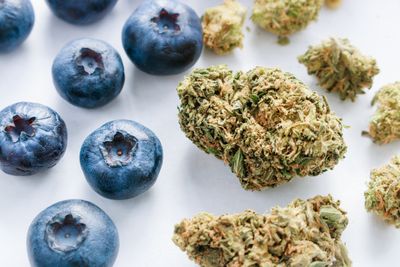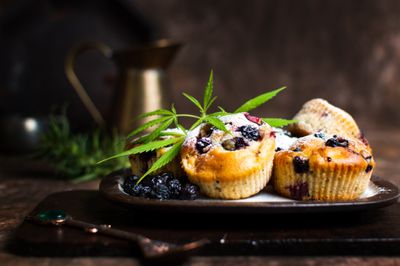Over the past two decades, “Blue” has, in a sense, become the new green. Browse a pot shop’s menu, and you’ll see products with names like Blue Dream, Blue Thai, Blue OG, Pacific Blue, Blue Kush, Blue Headband, Blue Magic, and Gorilla Blue. It’s like Eiffel 65 hired Bubba from Forrest Gump as their new frontman.
But among each of the names listed above — which is just a fraction of the “Blues” out there — there’s one consistent factor: Every one of ‘em likely spawned from a cross of the legendary Blueberry strain and some other plant.
A Brief History of Blueberry, the Strain
Blueberry’s history, like all legends, took on a life of its own over the decades. As it goes, some time at the end of ‘70s, famed weed breeder DJ Short returned from Asia with a plant that looked, smelled, tasted, and smoked like nothing the West had ever seen or blazed before. It’s purported genetic lineage, too, has been hazier than a college dorm bathroom with a wet towel shoved under the door. Some sources say Blueberry came from a cross of Purple Thai with a Thai landrace, while others claim it’s a three-way cross that includes an Afghani landrace, as well.
But in 2017, Willamette Week put the bedtime stories to rest. In an interview with JD Short, the son of DJ Short, the world learned that Blueberry is actually the product of four different cannabis chemovars.
"It's Thai, Chocolate Thai, Afghan, and Oaxacan," JD told Willamette Week. "Those were the four strains DJ started with. All his strains started with those genetics."
"When it first came out, what set his stuff aside was that he had stabilized the color purple, with berry and fruit," JD continued. "A lot of the herb that was around at that point was spice weed, or it was the Afghan, which was skunk. DJ came along with these things that were berry and purple, and it just blew people's minds."
Both DJ and JD are still breeding primo weed — DJ Short being based in California at Old World Genetics, and his son in Eugene, Oregon at the aptly named Second Generation Genetics. And they still offer Blueberry’s genetics to cannabis companies across the West Coast.
What Makes Blueberry So Damn Blue… and Berry?
Blueberry weed gets its blue and violet hues from anthocyanins, pigment molecules that only become visible where there’s no green chlorophyll on the buds or leaves. But anthocyanins, as far as we know, don’t do anything for the strain’s heady effects or its aromatic qualities. (Anthocyanins, however, may confer some health benefits.)
What set Blueberry apart from all of the skunk weed in the ‘80s was its unique terpene profile. Cannabis naturally produces terpenes for protection against the environment, but these molecules also generate the lush scents and unforgettable flavors that accompany Blueberry.
According to lab data at Leafly, Blueberry’s three most common terpenes are myrcene, caryophyllene, and pinene. The combination of myrcene and pinene’s herbal, floral essences with caryophyllene’s rabbit-punch to the senses would explain why Blueberry blew everyone away who first encountered it nearly half a century ago.
Does Every Strain with “Blue” in It Likely Come From Blueberry?
Short answer: In nearly every case, yes. Longer answer: If Blueberry wasn’t the strain’s parent, it was likely its grandparent.
Seriously, look on any weed strain database and just start scrolling through all the strains with “Blue” in their name. Within two generations of that plant’s lineage, you’ll more than likely find Blueberry somewhere in there. That’s just how powerful, ubiquitous, and stable Blueberry’s genetics have proven, despite 40 years of its existence.
And the name game also stands as a testament to the strain’s popularity: Blueberry is now so synonymous with “Blue” that it’s possibly been forever cemented into the weed community’s language, branding, and imagination.

